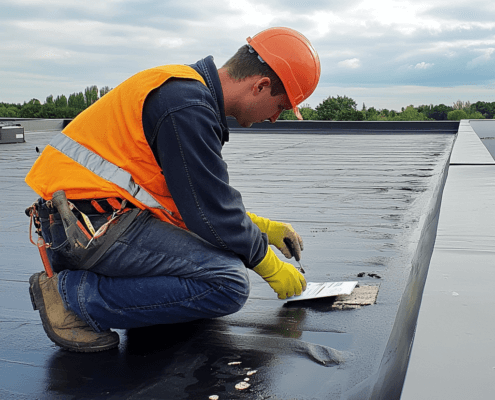What is a Flat Roof Detail?
A flat roof detail refers to the specific design, construction, and installation features that ensure a flat roof functions effectively. Unlike pitched roofs, flat roofs require special attention to drainage, waterproofing, and material durability. The right flat roof detail can make the difference between a roof that lasts for decades and one that requires frequent repairs.
Flat roofs are common on commercial buildings, garages, and some residential properties. Proper detailing is crucial for their performance because flat roofs don’t have the natural slope of pitched roofs to shed water. Without the right details, water pooling can lead to leaks, deterioration, and costly damage.
Why Flat Roof Detail Matters
Proper flat roof detail ensures that your roof has the following:
1. Efficient Drainage
Flat roofs are not entirely flat. They often have a slight slope, known as a “pitch,” to encourage water flow. Drainage is one of the most critical components of flat roof detail. Without it, water can pool on the surface, causing damage over time. Proper drainage elements like gutters, downspouts, and internal drainage systems are essential.
2. Waterproofing
Waterproofing is another key flat roof detail. Materials like EPDM, TPO, and PVC membranes are commonly used to create a watertight barrier. These materials must be properly installed to prevent leaks and protect the building from water damage. Seam sealing and proper flashing around vents, edges, and other openings are also critical parts of the waterproofing process.
3. Insulation
Flat roofs often require additional insulation to ensure energy efficiency. A well-insulated flat roof helps keep your building cool in the summer and warm in the winter. The insulation must be carefully installed to avoid creating weak spots or gaps where heat or cold can escape. This detail can significantly impact your energy bills.
4. Ventilation
Effective ventilation is an essential component of flat roof detail. Proper airflow helps regulate temperature and prevent moisture buildup, which can lead to mold and mildew growth. Vents, skylights, and other ventilation systems must be correctly integrated into the roof design to maintain optimal air circulation.
5. Material Selection
Choosing the right materials is an integral part of flat roof detail. The material must be durable enough to withstand the local climate and any stresses the roof will encounter, such as heavy snow, intense sunlight, or strong winds. The most common materials used for flat roofs include EPDM (ethylene propylene diene monomer), TPO (thermoplastic olefin), and PVC (polyvinyl chloride).

Regular inspections and maintenance are essential for preserving the flat roof details and preventing issues.
Key Elements of Flat Roof Detail
Here are the key elements that make up the flat roof detail:
1. Edge Details
The edges of the flat roof are often the most vulnerable to water damage. The edge detail includes flashing, trim, and waterproofing membranes that ensure the roof edge is sealed correctly. Poor edge detailing can lead to leaks, especially in areas with heavy rain or snow.
2. Drainage Details
Drainage is one of the most critical aspects of flat roof detail. Without proper drainage, water can pool on the roof, causing leaks, mold, and other issues. The drainage system typically includes roof drains, scuppers, and gutters to ensure water flows off the roof effectively. Proper slope and positioning of these systems are crucial for long-term performance.
3. Roof Penetration Details
Flat roofs have several penetrations, such as vents, skylights, and chimneys. These areas require special attention to ensure they are properly sealed and waterproofed. The flat roof detail around penetrations typically includes flashing, sealants, and reinforced materials to prevent leaks.
4. Expansion Joint Details
An expansion joint allows the roof to expand and contract with changes in temperature. Flat roof detail must account for the roof’s movement to avoid cracking or damage. Expansion joints are installed at specific points along the roof to prevent stress on the roofing material.
5. Roof Membrane Details
The membrane is the layer that provides the roof’s waterproof barrier. The flat roof detail includes ensuring the membrane is properly installed with no gaps or seams that could let water in. The membrane must also be compatible with other materials used in the roof system, such as insulation and flashing.
Common Flat Roof Detail Problems
If the flat roof detail is not carefully planned or executed, common problems can arise. Here are some of the most frequent issues:
1. Water Pooling
Without proper slope and drainage systems, water can pool on a flat roof. This is one of the most common issues with flat roofs. Water pooling can lead to leaks, damage to the roof structure, and premature roof failure.
2. Leaks and Moisture Damage
Leaks are often caused by poor installation of roofing materials, improper sealing around penetrations, or worn-out membranes. Moisture can seep into the building, causing extensive damage to the ceiling, walls, and insulation.
3. Insufficient Ventilation
Improper ventilation can lead to condensation, which can cause mold growth and damage to the roof structure. A well-ventilated flat roof helps prevent this issue by maintaining airflow and regulating temperature.
4. Inadequate Insulation
If the insulation is not properly installed or if it deteriorates over time, the roof may become inefficient, causing higher energy bills. Insufficient insulation also puts additional stress on the roofing material, reducing its lifespan.
How to Ensure Proper Flat Roof Detail
To ensure the best flat roof detail, follow these steps:
1. Work with an Experienced Roofing Contractor
Hiring a contractor with experience in flat roof installation and maintenance is crucial. They will know the specific requirements for your roof and ensure that all details are executed correctly.
2. Use Quality Materials
Choosing high-quality roofing materials ensures durability and long-term performance. Your roofing contractor can help you select the best materials for your specific needs.
3. Schedule Regular Maintenance
Regular inspections and maintenance are essential for keeping your flat roof in top condition. A professional roofer can identify and address potential issues before they become serious problems.
Why Choose CommercialFlatRoofs.ca for Your Flat Roof Needs?
At CommercialFlatRoofs.ca, we specialize in all aspects of flat roof installation, maintenance, and repair. Our team of experts understands the importance of precise flat roof detail in ensuring that your roof is durable, energy-efficient, and leak-free.
Here’s why you should choose us:
- Expert Knowledge: We have years of experience working with various flat roof materials, including EPDM, TPO, PVC, and more.
- Quality Materials: We use only the best materials for flat roof installations, ensuring long-term durability and performance.
- Comprehensive Services: From installation to maintenance and repair, we offer a full range of services tailored to your flat roof needs.
- Licensed and Insured: We are fully licensed and insured, giving you peace of mind knowing your roof is in good hands.
Contact us today for a free consultation and estimate! Let us help you design and install a flat roof with the perfect flat roof detail.
Recent Blog Posts Questions
What are the benefits of flat roofs over pitched roofs?
Flat roofs offer more usable space, easier maintenance, and cost-effective installation. They also provide an excellent surface for solar panel installation.
How long does a flat roof last?
A well-maintained flat roof can last between 20 and 30 years, depending on the materials and the climate.
What’s the best material for a flat roof?
The best material depends on your specific needs. EPDM, TPO, and PVC are popular options, each offering different benefits in terms of durability, energy efficiency, and cost.







